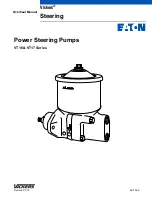
2-6
HSMSERIES OPR 052912
be fixed or variable, it may have predominantly resistive, capacitive or inductive parameters; it
may be located very close to the power supply output terminals or it may be a considerable dis-
tance away. The perfect interface between a power supply and its load would mean that the
specified performance at the output terminals would be transferred without impairment to any
load, regardless of electrical characteristics or proximity to each other.
The stabilized d-c power supply is definitely not an ideal voltage or current source, and practical
interfaces definitely fall short of the ideal. All voltage-stabilized power supplies have a finite
source impedance which increases with frequency, and all current-stabilized power supplies
have a finite shunt impedance which decreases with frequency. The method of interface
between the power supply output and the load must, therefore, take into account not only size
with regard to minimum voltage drop, but configuration with regard to minimizing the impedance
introduced by practical interconnection techniques (wire, bus bars, etc.). The series inductance
of the load wire must be as small as possible as compared to the source inductance of the
power supply: error sensing cannot compensate for reactive effects due to this. These dynamic
conditions are especially important if the load is constantly modulated or step-programmed, or
has primarily reactive characteristics, or where the dynamic output response of the power sup-
ply is critical to load performance.
2.7.5
LOAD CONNECTION - GENERAL
Load connections to the HSM power supply are achieved via the bus bars protruding from the
rear panel. The bus bars are each provided with two holes, one 0.34" diameter clearance hole
(for
5
/
16
" UNC threaded fastener) and one #10-32 threaded hole (see Figure 1-3). The threaded
hole is provided for attachment of error sensing leads from the signal connector when local
sense mode is desired.
Load cable or bus bar attachment should use the clearance hole, using a
5
/
16
" UNC nut, bolt
and lockwasher. The use of the proper fastener size and inclusion of a lockwasher are critical to
maintaining intimate contact between the load conductor and output bus bar; Kepco recom-
mends the use of fasteners made of conductive material (brass, phosphor bronze, etc.) to
enhance conductivity; for high current loads (>100A) Kepco recommends the use of Bellville-
style constant tension washers in place of conventional lockwashers.
NOTE
REGARDLESS OF OUTPUT CONFIGURATION, OUTPUT SENSE LINES
MUST BE CONNECTED FOR OPERATION. OBSERVE POLARITIES: THE
NEGATIVE SENSING WIRE MUST BE CONNECTED TO THE NEGATIVE
LOAD WIRE, AND THE POSITIVE SENSING WIRE TO THE POSITIVE
LOAD WIRE.
Summary of Contents for HSM 12-84
Page 2: ......
Page 5: ......
Page 6: ...iii Blank iv HSMSERIES OPR 052912 FIGURE 1 1 HSM SERIES POWER SUPPLY...
Page 10: ...1 4 HSMSERIES OPR 052912 FIGURE 1 3 OUTLINE DRAWING...
















































